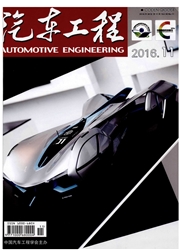

 中文摘要:
中文摘要:
为研究转速和初始压力对液力减速器性能的影响,调节变频器使减速器恒定在800~1 200r/min范围内的5种转速下运转,而在每一恒定转速下控制球阀开度使初始压力维持在0.01~0.1MPa范围内的7种压力时,测得不同转速和初始压力下制动转矩,并观察空化演进过程。研究发现,泵轮背面靠近外缘位置最先出现空泡;保持腔内初始压力恒定时,转速越高制动转矩越大;保持转速恒定时,未发生空化情况下,压力的变化对于制动转矩影响较小,而一旦发生空化,制动转矩随初始压力减小而急剧降低。结合制动转矩和空化特性,提出了液力减速器空化程度的判定准侧:以转矩变化率2.0%为界,将转矩变化率小于2.0%判定为未空化阶段;转矩变化率大于等于2.0%为空化(发展)阶段。
 英文摘要:
英文摘要:
In order to study the effects of rotating speed and initial pressure on performance of hydraulic retarder,by adjusting frequency converter to make retarder stably runs at one of five rotating speeds within the range of 800r/min to 1 200r/min,and at each rotating speed,by controlling the opening of ball valve to fix the initial pressure at one of seven pressures within the range of 0. 01 MPa to 0. 1MPa. In so doing,the braking torques under different speeds and initial pressures are measured,with the evolution process of cavitation observed. The results show that cavitation bubbles firstly emerge at the outer edge of impeller’s back side. With initial pressure kept constant,braking torque increases with the rise of rotating speed,and when rotating speed remains constant,the change of initial pressure has little effect on braking torque under non-cavitation condition. Once cavitation occurs,braking torque dramatically falls with the reduction of initial pressure. Combined with braking torque and cavitation characteristics,a criterion for judging the cavitation extent in hydraulic retarder is put forward: when the change rate of braking torque is less than 2. 0%,no cavitation happens,with retarder remains at the stage of non-cavitation; and when the change rate of braking torque is equal or more than 2. 0%,cavitation bubbles start to appear and then rapidly increase with the change rate of braking torque further rises,indicating that retarder enters cavitation( development) stage.
 同期刊论文项目
同期刊论文项目
 同项目期刊论文
同项目期刊论文
 期刊信息
期刊信息
